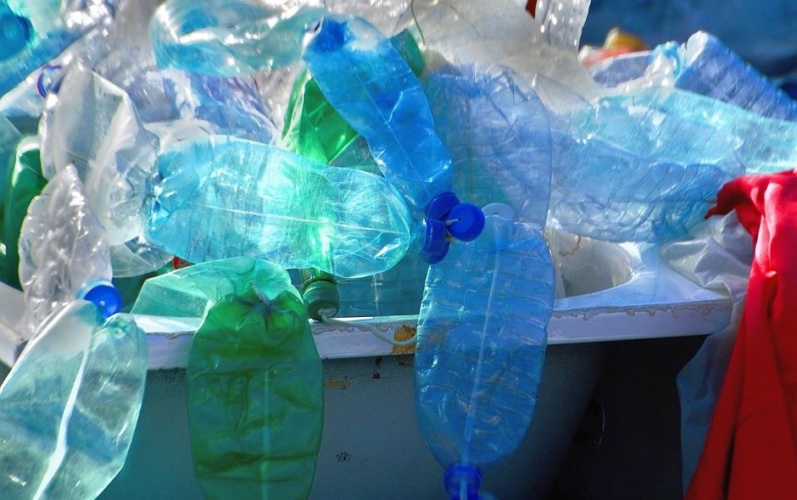 We are at a crossroads in recycling technology, so let’s choose a path that considers climate change and long-term economic success, says Jeffrey Dewey, research intern at Beam Project.
We are at a crossroads in recycling technology, so let’s choose a path that considers climate change and long-term economic success, says Jeffrey Dewey, research intern at Beam Project.
Plastic film is bulletproof glass to microbes. By keeping food fresh and microbe-free for weeks, plastic packaging reduces food insecurity and saves billions of dollars. Moreover, since food accounts for one quarter of all greenhouse gas (GHG) emissions, saving food reduces emissions. The benefits of plastics, unfortunately, are tarnished by their negative ecological and climate impacts.
Whether a stiff pipe or flexible fabric, 99% of all plastics today come from processing petroleum or natural gas into a solid. Fossil fuel and petrochemical companies are shifting investments towards plastics as renewable energy sources grow to displace them in meeting global energy demand. Since 2010, global investments in petrochemical facilities topped a staggering $200bn. The industry’s hopes lie in an estimated 3-4% annual increase in plastic demand over the next 30 years from developing countries in Africa, the Middle East, and Asia.

Increased GHG emissions are inevitable whenever fossil fuels are involved. A report from the Center for International Environmental Law calculated that plastic production currently accounts for more GHG emissions than aviation. By 2050, it is estimated that increased demand will translate to tripled annual emissions, approximately 2.8 gigatons CO2 equivalents (eCO2). The report notes policy can have dramatic impacts; eliminating single-use plastics globally would cut emissions by half. However, implementing global policies poses a significant challenge. Thus, growing demand for plastics, coupled with an increased awareness of its environmental damage, are fuelling interest in recycling technology innovations.
UK needs e-waste infrastructure to recover precious and critical metals
Pyrolysis, a type of chemical recycling, is currently leading the recycling investment race. Major companies, including Dow, BASF, Shell, General Electric, and Milliken, have recently partnered with pyrolysis-based startups. However, these investments ignore not only climate change, but also changing economic calculus.
What is pyrolysis? Plastic wrap dropped on a hot pan reacts with oxygen to generate CO2, other gases, and an impossible-to-clean black char; this is combustion. Heating plastic to 300-500 degrees Celsius in the absence of oxygen breaks it down into a mixture of petrochemicals and oils; this is pyrolysis. Pyrolysis only qualifies as recycling when the resulting petrochemicals and oils are resynthesised back into plastics instead of burned for energy. Proponents highlight the ability to use pyrolysis to process plastics that conventional recycling cannot. Unlike the Greek hero Achilles, however, this technology has not one but two fatal flaws: CO2 emissions and narrow marketability.
An independent calculation found that Agilyx, a pyrolysis firm partnered with General Electric, produced 3.23kg eCO2 for each kg of polystyrene (PS) processed. Similarly, BASF, a corporation that has itself invested in pyrolysis, found that pyrolysis of polyethylene (PE) produces 3.34kg eCO2 per kg fuel produced. As a comparison, synthesizing 1kg of new plastic requires between 3.1kg eCO2 (PS) and 1.8kg eCO2 (PE). Furthermore, simply landfilling 1kg of plastic waste only emits 0.06kg eCO2. Taken together, these data indicate pyrolysis has higher emissions than landfilling old plastic and producing new plastic. Mechanical recycling is the real emissions-saver; mechanically recycling and repurposing 1kg of plastic waste reduces CO2 emissions by 1.5-2.1kg eCO2 due to decreased plastic production.
Along with its GHG emissions, pyrolysis also possesses technological shortcomings that limit its ability to navigate unstable markets. Pyrolysis relies on high fossil fuel costs to outcompete virgin plastic resin and fossil fuels. Low oil prices disrupted pyrolysis in 2016, and now the pandemic, along with a Saudi-Russia price war, is driving plastic resin prices to historic lows. The technology is not versatile enough to compete. Pyrolysis is only efficient at recycling a subset of plastics that excludes polyethylene terephthalate (PET), which comprises 10% of all plastic waste. Furthermore, pyrolysis and other chemical recycling technologies cannot survive oil price instability by expanding into the rapidly growing market of electronic waste recycling.
I am pursuing a chemistry Ph.D. specifically because technologies can have a positive influence in the world. A recently discovered recycling technology, magnetic density separation (MDS), meets my utopian expectations of science.
Despite making up over half of plastic waste, polypropylene (PP) and PE cannot be separated by traditional mechanical recycling. MDS conquers this challenge by using magnetic iron oxide nanoparticles to modulate the apparent density of water, thus separating and purifying the denser PP from lighter PE. When powered by a renewable energy grid, MDS is almost entirely CO2 emission free.
MDS has another advantage over chemical recycling technologies like pyrolysis: its versatility. As was recently pointed out in The Engineer, recovering precious metal waste from electronics is a growing economic and ecological concern. However, with a few system adjustments, MDS has the ability to sort not only plastics, but also metals, by their inherent density.
Pyrolysis is currently diverting investments away from climate friendly technologies like MDS. However, we are still at a crossroads in recycling technology; let’s choose a path that considers both climate change and long-term economic success.
Jeffrey Dewey, Ph.D. Candidate, Department of Chemistry, University of Chicago










Water Sector Talent Exodus Could Cripple The Sector
Maybe if things are essential for the running of a country and we want to pay a fair price we should be running these utilities on a not for profit...